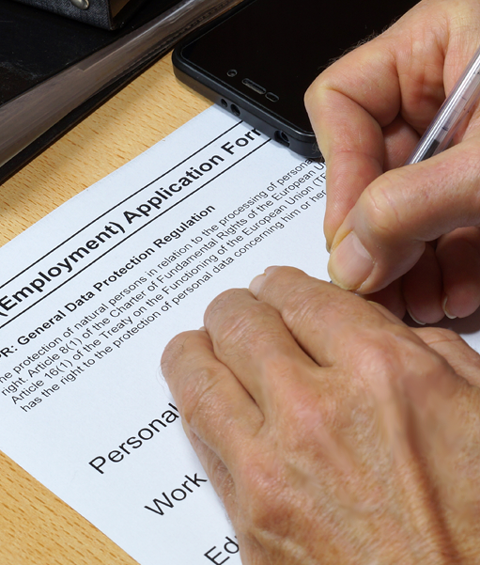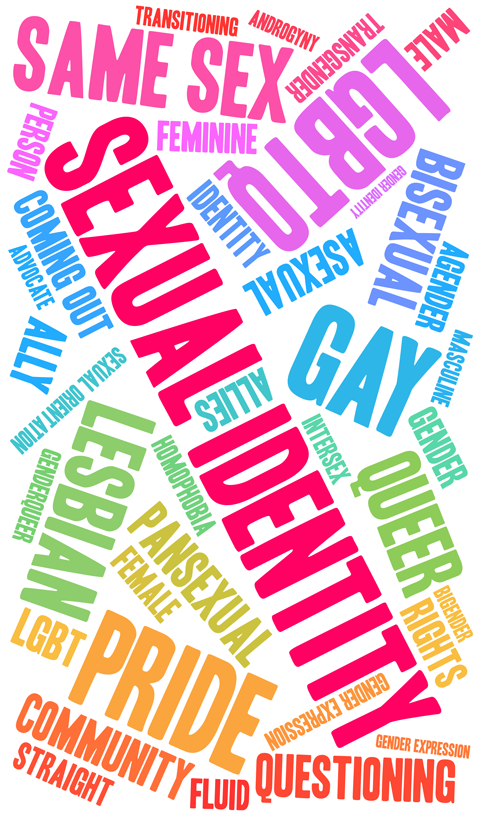Names and Pronouns: Talk to Me
The way you address people can have a significant impact on whether your interactions are viewed as positive and respectful. In most cases, people have good intentions in how they address others, but they may be afraid to ask questions out of fear of offending someone. For people who are transgender, gender nonconforming, or nonbinary, this topic often has a more significant impact because they are more frequently addressed or referred to incorrectly. You should stay informed about terms and vocabulary used to address others respectfully. This topic will provide you with information and strategies for how to respectfully address people in the workplace.
Click the links with  to jump directly to that section on this page.
to jump directly to that section on this page.
- Say My Name: From Miguel to Maria and Why it Matters
- Appropriate Pronoun Use
Say My Name: From Miguel to Maria and Why it Matters
Using the correct name to identify a person is an important part of showing respect. This topic will help you understand the process and significance of name changes for members of the transgender and gender nonconforming (TGNC) communities and the importance of using the correct name when addressing or referencing a person.
- How, When, and Why Do Name Changes Occur?
- Chosen Names, Birth Names, and Dead Names
How, When, and Why Do Name Changes Occur?
Some people who are transgender, gender nonconforming, and/or nonbinary choose to change their name to one that better reflects the person they are. The process of changing one's name and how people announce their name change varies on an individual basis.
When Jacqueline was born, her parents named her after her grandmother and painted her room pink. From a young age, Jacqueline preferred clothes and toys from the "boy's section" of stores. As Jacqueline grew older, she realized that she neither felt like a woman nor did she identify with being a woman. She also did not feel like a man. She felt somewhere in between. She started to change how she dressed and looked to reflect that feeling. After cutting her hair and starting to dress in a manner that hid her figure, Jacqueline decided that she would prefer to be called Jay because it aligned with her identity. Jay asked friends and family to call her Jay and told them that she was comfortable using the pronouns she/her/hers or he/him/his. Jacqueline made a legal name change to Jay. It took some of Jay's friends and family members time to remember to use the correct name. Over time, they became used to it and many did not remember that Jay ever used a different name.
Each person's reason and method for name and pronoun change may be different, and the outcome may have a direct effect on the mental health of the individual. An individual being called the wrong name or pronoun may experience negative mental health outcomes. It can also result in danger or violence for the individual.
While there is a specific legal process to legally change one's name, many individuals begin their transition with an informal process of simply using a different name. Some individuals change their first name to a name that better reflects their sense of self and their gender identity. Others choose a name that has a special significance, perhaps relating to a family member or mentor. Others choose a name that is similar in spelling or pronunciation to their birth name.
Chris V legally changed his first and last name three years ago. Initially, Chris planned to only change his first name and maintain his last name because he was proud of his family heritage. However, Chris works in a field where being transgender is not accepted, and Chris knew that he could not safely tell his colleagues he is a transgender man. He also knew it would not be a safe work environment if any colleagues did a search of his family last name and learned he was transgender. Therefore, Chris decided to change his entire name to ensure that it would not be easy for others to use the internet to find any links between his past name and his past name and assigned gender, and his current life as a transgender man.
Some people choose to informally change their name while others choose to legally change their name. Legal name changes take time and resources. A legal change is not required for an individual to adopt a chosen name to be used when addressing them.
Once a person has decided upon a name, they need to decide how and when they will begin using that name and asking others to do the same. Some individuals prefer to change their e-mail signature or mention it one-on-one in casual meetings. Others prefer to make a more formal announcement and explain their choice and process. Some people start using a different name before changing any aspect of their physical appearance. Others wait until they are dressing differently or pursuing gender-affirming health care to begin using a new name. Others may not change their physical appearance and just wish to use a different name or pronouns.
If you are unsure of what name a person is using, approach the person in a private setting and respectfully ask what they would like to be called. Most people prefer to be asked than to be addressed incorrectly. Asking in a private space avoids accidentally outing someone or bringing attention to the use of a new name.
As with all stages of changing a name (or pronoun, which is discussed under pronouns), each person chooses how to work through this process. You should be respectful and not make assumptions about when or why an individual should or should not announce a name change.
Regardless of whether someone has legally changed their name or when they announce their name change, it is not appropriate to continue to call someone by a name they no longer use. To continue to call someone a different name than what they have requested is disrespectful, displays poor customer service, and may constitute harassment or discrimination.
Chosen Names, Birth Names, and Dead Names
Once a person has informed you of the name they use, you should use that name going forward and stop using the previous name. If this is a person whom you have known for some time, it may take you a while before you get used to the person's name; however, it is not appropriate to reference the prior name or disclose it to others. If you accidentally use the wrong name, it is best to apologize and recommit to learning the chosen name.
Many people refer to their new name as their name. However, in the context of discussing name changes, it may also be called a chosen name.
The name that a person was previously known by is referred to as a birth name or a deadname. There is no correct term for this type of name; each person uses the label that they feel is most appropriate.
The term birth name refers to the name given to the individual at birth. The term deadname references the feeling that the name represents a person or an identity that is no longer valid. Many people who use the term deadname have negative associations with that name and the identity connected with it.
Using the correct name is important for several reasons:
- It is a sign of respect to address someone by their chosen name. To intentionally call someone by the wrong name may constitute harassment or discrimination.
- Not all transgender and gender nonconforming (TGNC) people are out in the workplace. By using an incorrect name, you may out that person to colleagues that the person is a member of the TGNC communities.
- The correlation between affirming a person's gender identity and that person's mental health and emotional well-being is well documented. Using their chosen name can positively affect a person, whereas using an incorrect name can cause undue distress or harm.
To Top
Appropriate Pronoun Use
Using the correct pronouns when addressing or referencing a person is an important component of a respectful work environment and is essential for creating strong customer service. This topic will provide you with best practices for appropriate and respectful pronoun use in the workplace.
- He, She, They: What's Your Pronoun?
- Best Practices for Comfortable Pronoun Usage
- Best Practices for Correcting Pronoun Mistakes
He, She, They: What's Your Pronoun?
Some people find it confusing or uncomfortable to discuss pronouns. Many people have been exposed to only two options—he and she—and have believed those two options had very specific meanings. This belief was that people classified as male or assigned a male gender used the pronoun he and people who classified as female or assigned a female gender used the pronoun she.
As our understanding of sex and its relation to gender shifts, so does the language that we use. The three most commonly used pronouns to refer to individuals are he, she, and they. Some people may consistently use only one of these pronouns; others may use several pronouns to best reflect their identity.
Some people express discomfort using the pronoun they to refer to a single person because they feel it is grammatically incorrect. While many people were taught that they is a plural pronoun, this is no longer true. As with many aspects of the English language, accepted practices evolve over time. Recently, the Associated Press 2017 Stylebook formally included the use of they as a singular pronoun. By including it, they recognized that many people already used the word in this manner in the following situations:
- When the person in question is unknown (e.g., "Someone left their phone in the conference room.").
- When someone who does not identify as he or she needs a pronoun to use (e.g., "Ryan asked me to review their quarterly report and provide feedback.").
Less commonly, some people will use other gender-neutral pronouns. See the examples below.
| Subjective |
Objective |
Possessive |
Reflexive |
Example |
| She |
Her |
Hers |
Herself |
She went to the store.
I spoke to her.
This desk is hers.
|
| He |
Him |
His |
Himself |
He went to the store.
I spoke to him.
This desk is his. |
| They |
Them |
Theirs |
Themself |
They are speaking.
I spoke to them.
This desk is theirs.
|
| Ze |
Zir |
Zirs |
Zirself |
Ze went to the store.
I spoke with zir.
This desk is zirs.
|
| Xe |
Xem |
Xirs |
Xirself |
Xe went to the store.
I spoke to xem.
This desk is xirs.
|
Note: Ze/zir/zirs/zirself and xe/xem/xirs/zirself are both pronounced "zee/here/heres/here-self."
Drew is genderqueer and uses the pronouns he/him/his and they/them/theirs. They have a buzz cut and usually wear a button-down and slacks. Drew does not feel comfortable identifying exclusively as male and appreciates when colleagues alternate between the different pronouns to refer to him. Accordingly, sometimes people use they and sometimes people use he to refer to Drew.
Joe is nonbinary and does not identify exclusively with a male or female identity. As such, Joe prefers that people use both the pronouns she/her/hers and he/him/his or to use Joe's name.
Shivani identifies as gender nonconforming and uses they/them/theirs pronouns. Although it is upsetting when people accidentally use the wrong pronouns, Shivani knows these pronouns are right for them and who they are.
Because there is no objective standard for determining a person's gender or pronouns, it is important not to make assumptions about the pronouns that an individual uses.
For example, a person with short hair, no make-up or jewelry, with a traditionally "masculine" style of dress might be a man who uses the pronouns he/his/him. However, this person could also be a woman who uses the pronouns she/her/hers. The person could also identify with another gender and use the pronouns he, she, they, or any combination thereof.
Best Practices for Comfortable Pronoun Usage
If you are meeting someone new and do not know their pronouns, it is best to avoid making assumptions. Respectful options include:
- Addressing a person by their name if you are unsure of what pronouns to use.
- Providing your own pronouns first (e.g., "My name is Ashley; I use she and hers.").
- Asking respectfully in a private space what pronouns they use (e.g., "Hi Jordan, I'd like to introduce you to my colleague. What pronouns do you use?").
- Using they as a gender-neutral pronoun until you know the correct pronouns to use.
When asking someone about their pronouns, it may feel unfamiliar—or even uncomfortable—at first. While some people may be taken by surprise if asked about pronouns, many will appreciate that you asked them rather than made assumptions about their identity. At all times, it is important to be respectful to that individual.
If someone has recently started using a new pronoun or name, it is appropriate to ask them who they have shared that information with and whether they want you to call them by the new name or pronoun in all situations or only certain ones.
Individuals may want to tell people about a name change themselves or may only use the name and pronouns in situations they feel safe. If the employee indicates that they have shared this information with only you and are not ready to take further action or share it with others, then it is important to keep their information private.
If you are Human Resources personnel, it is particularly important to be aware that this information requires confidentiality and may be protected under federal and State law. When the employee has determined that they are ready to use a different name or pronouns in the presence of others, you and the employee can work together to determine the best way to share this information with others. Please see Information for Supervisors and Human Resources Personnel for more information on best practices and transition planning.
Best Practices for Correcting Pronoun Mistakes
Most people want to be respected and recognized for who they are regardless of their gender identity. It is appropriate to sincerely inquire about an employee's or a customer's name or pronoun to ensure they are being addressed correctly.
The concept of gender is more complex than the binary of male and female. The use of pronouns to be reflective of varying genders and gender identities is new to many people. As with any new idea or practice, it is common to have questions and make mistakes.
Below are some best practices if you have made a mistake:
- Apologize: A simple and sincere apology, followed by a commitment to avoid making the mistake in the future, is a good response.
- If this occurs with someone you are just meeting, and you didn't know their correct pronouns, it is appropriate to ask and confirm their pronouns to help avoid making the same mistake in the future.
- If this occurs because the person recently started using a different name and/or pronouns, and you used an incorrect name or pronoun out of habit, simply apologize and make a sincere effort to use the correct identifier in the future.
- Correct yourself and move forward. Repeat what you said with the right pronoun and continue the conversation.
- It is unnecessary to offer an excuse (e.g., "I'm sorry—it's hard to start thinking of you as he when I've always known you as a woman!").
- It is unnecessary to apologize profusely (e.g., "I'm so sorry, I'm so embarrassed, I never do that.").
- It is also important to avoid excessive gender identity affirmations that may come off as insincere (e.g., "Girl, I can't believe I just did that—with your nails painted and hair done—you're more of a woman than I am!").

 to jump directly to that section on this page.
to jump directly to that section on this page.
